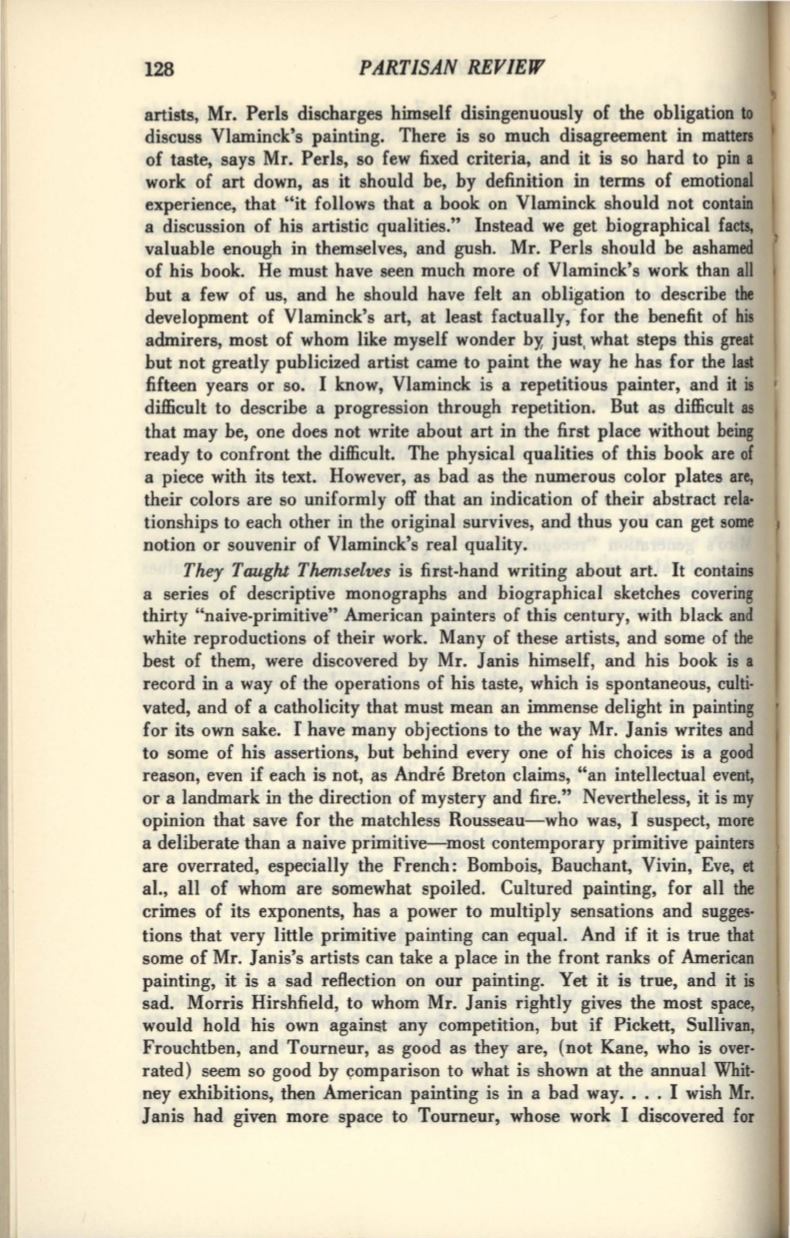
128
PARTISAN REVIEW
artists, Mr. Perls discharges himself disingenuously of the obligation
to
discuss Vlaminck's painting. There is so much disagreement in matten
of taste, says Mr. Perls, so few fixed criteria, and it is so hard to pin a
work of art down, as it should be, by definition in terms of emotional
experience, that "it follows that a hook on Vlaminck should not contain
a discussion of his artistic qualities." Instead we get biographical facts,
valuable enough in themselves, and gush. Mr. Perls should be ashamed
of his book. He must have seen much more of Vlaminck's work than all
but a few of us, and he should have felt an obligation to describe
the
development of Vlaminck's art, at least factually, ·for the benefit of his
admirers, most of whom like myself wonder by, just,what steps this
great
but not greatly publicized artist came to paint the way he has for the last
fifteen years or so. I know, Vlaminck is a repetitious painter, and it is •
difficult to describe a progression through repetition. But as difficult as
that may be, one does not write about art in the first place without being
ready to confront the difficult. The physical qualities of this book are of
a piece with its text. However, as bad as the numerous color plates are,
their colors are so uniformly off that an indication of their abstract rela·
tionships to each other in the original survives, and thus you can get some
notion or souvenir of Vlaminck's real quality.
They Taught Themselves
is first-hand writing about art. It contains
a series of descriptive monographs and biographical sketches covering
thirty "naive-primitive" American painters of this century, with black and
white reproductions of their work. Many of these artists, and some of the
best of them, were discovered by Mr. Janis himself, and his book is a
record in a way of the operations of his taste, which is spontaneous, culti–
vated, and of a catholicity that must mean an immense delight in painting
for its own sake. I have many objections to the way Mr. Janis writes and
to some of his assertions, but behind every one of his choices is a good
reason, even
if
each is not, as Andre Breton claims, "an intellectual event,
or a landmark in the direction of mystery and fire." Nevertheless, it is my
opinion that save for the matchless Rousseau-who was, I suspect, more
a deliberate than a naive primitive-most contemporary primitive painters
are overrated, especially the French: Bombois, Bauchant, Vivin, Eve,
et
al., all of whom are somewhat spoiled. Cultured painting, for all
the
crimes of its exponents, has a power to multiply sensations and sugges–
tions that very little primitive painting can equal. And if it is true that
some of Mr. Janis's artists can take a place in the front ranks of American
painting, it is a sad reflection on our painting. Yet it is true, and it
is
sad. Morris Hirshfield, to whom Mr. Janis rightly gives the most space,
would hold his own against any competition, but if Pickett, Sullivan,
Frouchtben, and Tourneur, as good as they are, (not Kane, who is over–
rated) seem so good by c;:omparison to what is shown at the annual Whit·
ney exhibitions, then American painting is in a bad way.... I wish Mr.
Janis had given more space to Tourneur, whose work I discovered for


